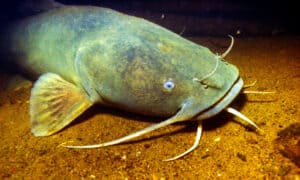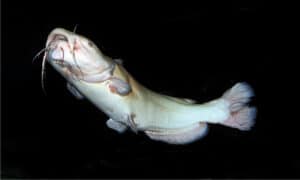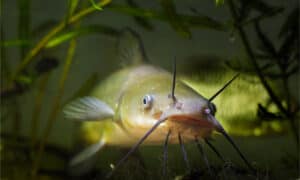Are you ready for the tale of the biggest catfish to ever grace the waters of Louisiana? Meet the channel catfish, a fierce and elusive creature known to reach impressive sizes.
Did you know there are now over 3,000 species of catfish in over 36 families, with many more waiting to be discovered?
The channel catfish, also known as Ictalurus punctatus, is prevalent in North America. It’s so popular that it’s the official fish of several states in the US, including Kansas, Missouri, and Iowa. Further, people often refer to it casually as a “channel cat.”
It is estimated that eight million American anglers travel in search of them annually, making them the most popular species of catfish. Channel catfish’s skyrocketing appeal as a culinary staple in the United States has fueled the sector’s rapid expansion.
As a result of its widespread introduction, it is now designated an invasive species in several nations, including Europe, Asia, and South America.
Let’s dive into the story of this monstrous fish and the angler who reeled it in.
The Largest Channel Catfish Ever Caught In Louisiana
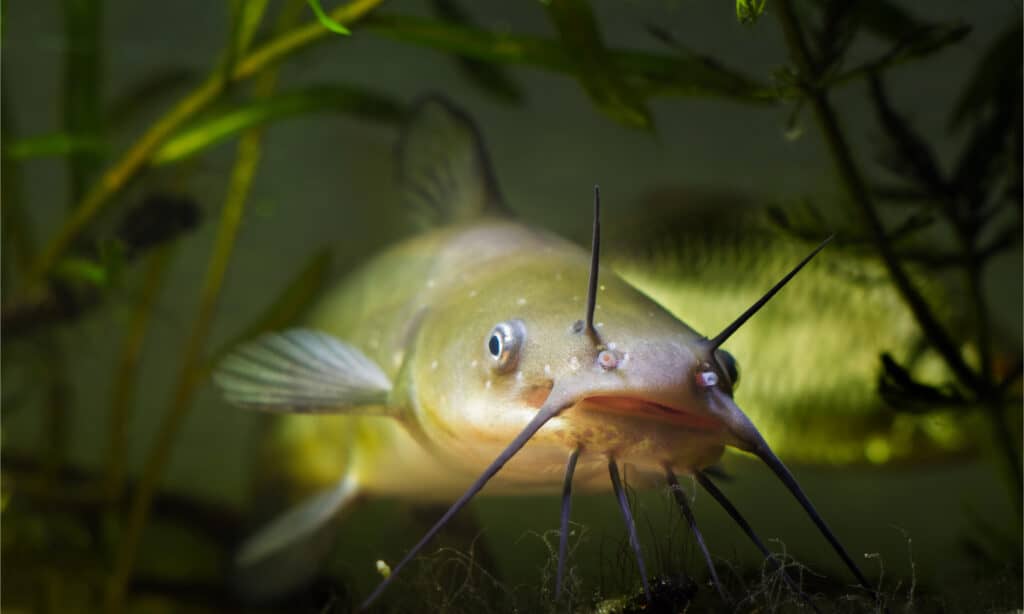
©Aleron Val/Shutterstock.com
The state record for channel catfish is an impressive 30.31 pounds caught by Harold W. Clubb in August 1977 in the Minorcan/Intracoastal area.
This catch holds the first rank in the state record for channel catfish. This catch is considered a spectacular specimen and a testament to Louisiana’s outstanding fishing opportunities.
However, while this catch was a truly massive channel catfish, it’s worth noting that the state has produced three different blue catfish that weighed more than 100 pounds!
And the largest flathead catfish in Louisiana weighed an incredible 95 pounds. It was caught in July 2007 in Wax Lake.
What Kind Of Catfish Are Caught In Louisiana?
Acclaimed for its abundance of unique catfish species, Louisiana is a popular fishing destination. Blue catfish, channel catfish, and flathead catfish are the “big three” of the North American catfish found here.
It’s one of the only places where you can catch all three of these species in the same body of water, known as a “catfish grand slam” among anglers.
Additionally, you can find small species of catfish, such as the brown bullhead, in Louisiana. They are smaller than the other species, but they’re still a popular fish to catch and eat.
Channel catfish are particularly well-known for their delicious taste and are often raised on fish farms throughout the state.
They usually weigh 4-8 pounds, but it’s possible to catch some that weigh over 10 pounds.
Channel Catfish Habitat
The channel catfish is native to North America and widely distributed over the continent. However, many other regions, including Europe and Asia, have also been exposed to them.
They are adaptable aquatic organisms that may make their home in various water bodies.
Channel catfish, like many other fish, seek out sheltered places like holes and garbage to lay their eggs. They’re primarily found in the Great Lakes region in Canada, starting from Lake Nipigon and going south.
Characteristics Of Channel Catfish

Channel catfish have a highly developed sense of taste.
©iStock.com/v_zaitsev
A common misconception is that their barbels can “sting” people when touched. One characteristic that sets channel catfish apart is their highly developed sense of taste. They have taste buds all over their body, including inside the oropharyngeal cavity, which makes them very sensitive to amino acids.
This sensitivity is exceptionally high for L-alanine and L-arginine, present in freshwater. When they sense these amino acids in their environment, they become more active in their search for food. This behavior is known as “swimming tongue” and is caused by the taste receptors’ excitation, which leads to excessive biting, turning, or chewing.
A Typical Channel Catfish Length And Weight
The channel catfish, Ictalurus channelus, is a large American catfish that can reach 40 to 50 pounds at maturity (18 to 23 kilograms). A channel catfish weighing 58 pounds was recorded in South Carolina’s Santee-Cooper Reservoir on July 7, 1964, setting a new world record for the species.
While catching large channel catfish is possible, it is rare. A fish over 20 pounds (9 kilograms) is considered a large catch, as most anglers are thrilled with a catch of 10 pounds or more.
The average channel catfish that anglers can expect to catch is between 2-4 pounds and 12-24 inches in length.
It’s worth mentioning that channel catfish and their relative, the blue catfish, which tends to grow considerably larger, can sometimes be seen sharing the same rivers.
It has been established that there are blue catfish in the world that weigh more than a hundred pounds. Typically, the weight of a channel catfish will increase as it matures and increases in length.
What Does The Channel Catfish Feed On?
Adult channel catfish have a varied diet that features fish like the yellow perch, sunfish, and other aquatic creatures and plants. Snails, clams, crayfish, snakes, frogs, tadpoles, aquatic plants, algae, small fish, insects, seeds, grains, nuts, and the occasional small bird or small animal make up a portion of their diet. Younger channel catfish are more likely to eat plants and animals, indicating their greater omnivorousness.
How To Catch A Giant Channel Catfish
Since channel catfish are omnivores, many common natural and artificial bait, such as crickets, hot dogs, and nightcrawlers, can be used to catch them. In addition, ivory soap and raw steak have also been used successfully.
Channel catfish can be caught using various methods, not just rod and reel. One such method is the use of juglines. You can also use wire hoop traps or slat traps, which are lengthy wooden traps.
Such traps can be baited with anything from rotten fish to spoiled food (“stink bait”). Noodling is an unusual method of hand-fishing for catfish that has gained popularity in the Southeast.
When removing the hook from a catfish, care must be taken to avoid the spines on the fish’s pectoral and dorsal fins.
Challenges Faced In Catching The Channel Catfish
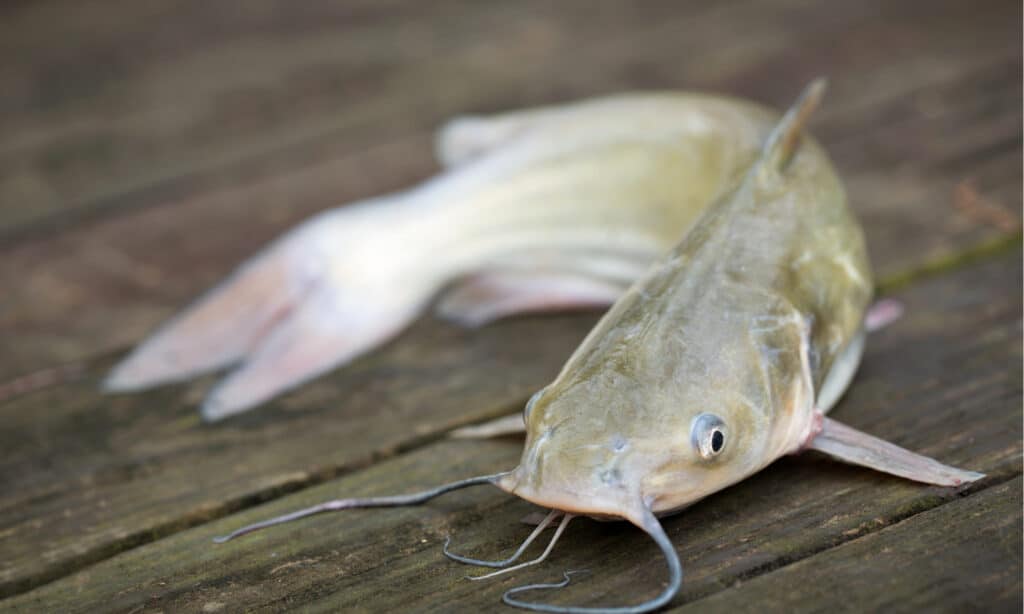
Channel catfish can be a challenge to anglers.
©Jennifer White Maxwell/Shutterstock.com
Catching channel catfish can present several challenges for anglers. Below are a few:
Locating The Fish
Even in murky or otherwise unappealing water, channel catfish can locate and consume prey because of their excellent senses of smell and taste. Unfortunately, anglers may have difficulty locating fish concentrations in these conditions.
Presenting The Bait In A Way That Will Attract The Fish
Channel catfish have a keen sense of taste and can detect the presence of certain amino acids at low concentrations. Unfortunately, this means that anglers may have to experiment with different types of bait and presentation methods to attract the fish effectively.
The Size Of The Fish
Channel catfish can grow quite large and are known for putting up an intense fight when hooked. This can make them challenging to reel in, especially for inexperienced or less physically fit anglers.
Variety Of Different Habitats
There are various freshwater bodies, such as rivers, reservoirs, natural lakes, and ponds. This means that anglers may have to adapt their techniques depending on the water they are fishing in.
Channel Catfish Are Considered An Invasive Species
In some places, channel catfish are considered invasive, meaning they may not be legal to catch or possess. Therefore, anglers should familiarize themselves with the specific regulations in their area before fishing for channel catfish.
How Channel Catfish Changed The Fishing Industry And Community In Louisiana
The channel catfish is an important species for Louisiana’s fishing industry and community.
The state’s warm, nutrient-rich waters provide ideal conditions for the fish to thrive, and as a result, Louisiana is one of the top producers of farmed catfish in the United States. This has led to a significant economic impact on the state, providing jobs and income for many Louisianans.
Channel catfish’s rising profile as a culinary staple has fueled demand for the fish in Louisiana and other states. This has led to expanding fish farms and processing plants throughout the state, creating jobs and economic growth.
Channel catfish hold a special place in the culture and history of Louisiana. The fish is a popular target for recreational anglers and is often featured in local festivals and events. In addition, many families in the state have a tradition of catfishing passed down from generation to generation.
The channel catfish has played a significant role in shaping Louisiana’s fishing industry and community. It is an important species for both the economy and the culture of the state and continues to be enjoyed by many people for its taste and the sport of catching it.
The Best Places To Catch Channel Catfish In Louisiana
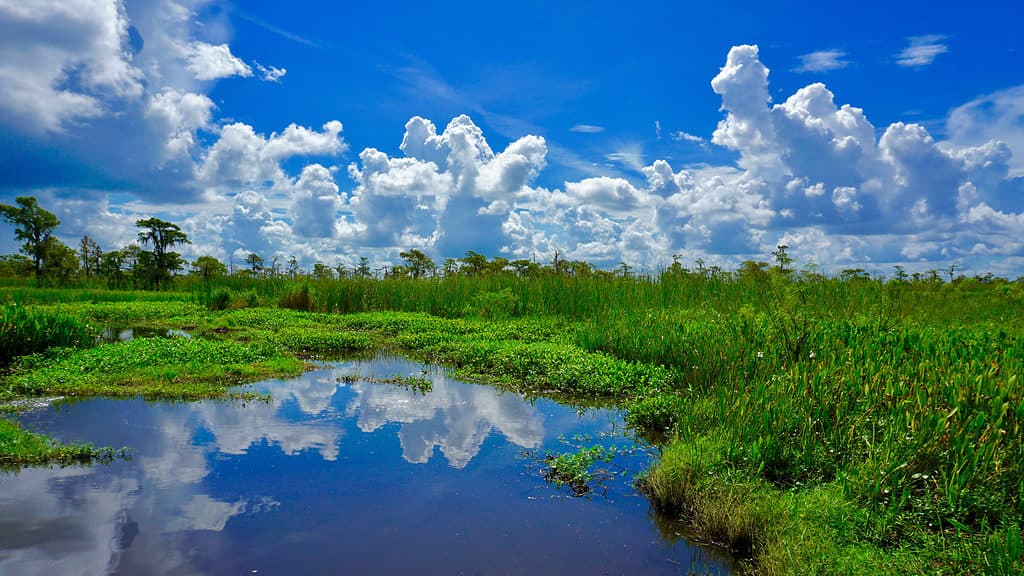
Channel catfish can be found across Lousiana lakes and rivers.
©Josh Healy/Shutterstock.com
The mighty Mississippi River is a great place to start if you want tremendous catfishing spots in Louisiana.
You’ll find catfish along the river and its many tributaries and channels. But Louisiana also offers some other famous rivers and lakes worth exploring.
Lake Providence
This ancient oxbow of the Mississippi River is located in Northeast Louisiana and is considered a prime fishing destination. The lake is surrounded by a heavily wooded area and offers healthy populations of channels, blues, and flatheads and some excellent bass fishing. During the winter months, catfish tend to seek heavy cover, and during the summer, you can find them in shallow flats along the lake’s edge, especially at night.
Upper Ouachita River
This river flows south of Arkansas and into Northeast Louisiana; it often gets overlooked compared to the more famous Red and Mississippi Rivers.
It also has some significant catfish populations. Flatheads are more common in the upper section of the river, and you can find blues and channels throughout the entire watershed.
Lake D’Arbonne
This is the place to go if you want to fill your cooler with delicious channel catfish. The lake is known for its high number of channel cats, but you can also find some big flatheads here.
Toledo Bend
This is one of the largest reservoirs in the state at 185,000 acres. It has an enormous catfish population, and since most anglers focus on crappie and bass fishing, the catfish here are relatively unpressured.
After heavy rains, focus on the tailrace area below the dam for good catfishing.
The Red River
This is also an excellent spot for catfishing. It is a famous fishing destination in its own right and supports healthy populations of blue, channel, and flathead catfish.
Look for areas downstream and fast-moving water where deep holes and fallen structures accumulate. The lower the water levels, the better the fishing.
Bottom Line
The channel catfish is a beloved species in Louisiana, and anglers from all over the state come to catch these fish.
The state record for channel catfish is an impressive 30.31 pounds caught by Harold W. Clubb in August 1977 in the Minorcan/Intracoastal area. This record showcases the potential size of these fish and the great fishing opportunities that can be found in the state of Louisiana.
The channel catfish is a widespread species for recreational anglers and the aquaculture industry. Its delicious taste and the sport of catching it make it a favorite among many. So whether you’re a seasoned angler or a beginner, Louisiana is a great place to explore and discover the joys of catfishing.
Where Is Louisiana Located On A Map?
Louisiana is located in the southern part of the United States. It is bordered by Texas to the west, Mississippi to the east, Arkansas to the north, and the Gulf of Mexico to the south. Wax Lake is located in the southern part of the state, situated in the Atchafalaya River Basin.
The photo featured at the top of this post is © iStock.com/v_zaitsev
Thank you for reading! Have some feedback for us? Contact the AZ Animals editorial team.



